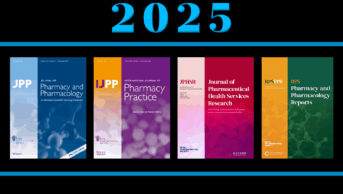As I write, The Lancet has just published its 2023 report ‘Countdown on health and climate change: the imperative for a health-centred response in a world facing irreversible harms’. There are some stark warnings: climate change is making health-threatening temperatures increasingly frequent, the pressure on healthcare systems is rapidly growing, transmission of life-threatening infectious diseases is rising, and so on. The report makes various recommendations, which include “promoting leadership from the health sector by delivering health-promoting climate change action”.
Consequently, I was delighted to see the Royal Pharmaceutical Society (RPS) consulting this autumn on its new ‘Greener Pharmacy Guide’, a toolkit that enables pharmacy teams to self-assess their efforts to achieve net zero emissions, which will be launched alongside a new online platform in spring 2024. These guides were promoted at the 2023 RPS Annual Conference, during a session designed around the International Pharmaceutical Federation (FIP)’s development goal 21: sustainability in pharmacy, chaired by Lars-Åke Söderlund, vice president of FIP. During this session, a recently formed team of international partners, with whom I work, also made a presentation asking if “take-back and redistribution” can become a sustainable solution to the problem of medication waste. As I listened, I wondered if one positive step toward dealing with climate change was for us all to identify as green-collar workers — a “workforce whose tasks seek to increase sustainability and to decrease waste, energy use, and pollution”. As an insightful editorial about our response to climate change in the International Journal of Pharmacy Practice recently put it: “Health professionals must be powerful advocates for both restoring biodiversity and tackling climate change for the good of health … But first, we must recognise this crisis for what it is: a global health emergency.” My focus this month, then, is on papers related to sustainability in pharmacy.
As the RPS sustainability policies highlight, an important role for pharmacists is to optimise medicines use, and this might include addressing medication non-adherence. The first paper I read focuses on patterns and factors associated with selective serotonin reuptake inhibitor (SSRI) medication adherence. Published in the Journal of Pharmaceutical Health Services Research (JPHSR), the authors of this retrospective, Florida-based study scrutinised data from a ‘pharmacy claims’ database with more than 15,800 ‘enrollees’ over a six-year period (2015–2020, inclusive). The final sample contained 2,541 individuals who had filled two or more consecutive SSRI prescriptions for any of: citalopram, escitalopram, fluoxetine, fluvoxamine, paroxetine, sertraline, vilazodone and vortioxetine. Briefly, conceptualised as cause–effect, the dependent variable (effect) was derived using the proportion of days covered (PDC) calculation, by “dividing the number of days in the period covered by the medication, by the number of days in the period”, with patients considered adherent if PDC was equal to 80% or more and non-adherent if less than 80%. The independent variables (causes) that were tested for any associations with SSRI adherence were numerous and classified into three categories: sociodemographic factors, healthcare access factors and clinical- and medication-related factors.

Data relating to these variables were then examined using multiple logistic regression analysis, enabling the authors to test the significance of any associations. I urge readers to access this paper for the numerous findings, but want to highlight one of the results in particular. The authors report that “better healthcare access” was positively associated with adherence, while defining better access as “using mail-order pharmacies”, where patients were 60% more likely to be adherent compared with those who did not use mail-order pharmacies. They reason that mail-order pharmacies (also known as online pharmacies) eliminate face-to-face interactions, thus providing privacy to patients, as a potential explanation. I certainly find this food for thought and question my own assumptions about the role that pharmacists might play in improving adherence.
Tackling the waste that arises from unused medicines is of course another facet of our work, which also relates to sustainability in pharmacy. The second paper that caught my attention was a cross-sectional study conducted in Indonesia to examine the awareness and beliefs of community pharmacists on the disposal of unused and expired household medication. Published in JPHSR, the authors employed opportunity sampling to ask pharmacists taking part in a virtual training event to self-complete an online survey. Participants were asked about their awareness of harm caused by improper disposal of medicinal waste, as well as their thoughts on where such medicines might best be collected for safe disposal. Context is important here — the authors explain that while some pharmacies in Indonesia might offer medication take-back programmes, this is voluntary and unfunded. The current study therefore provides baseline data for any future scheme for the collection of expired or unused household medication. The findings are positive. Nearly all pharmacists who participated, declared awareness of the environmental harm from improper disposal of household medication, believing community pharmacies to be the appropriate place for the collection of medication waste. Considered against the first paper, above, I wonder how mail-order pharmacies, if they continue to flourish, will discharge their responsibilities when it comes to the take-back of unwanted household medicines.
The third paper I read this month was published in the Journal of Pharmacy and Pharmacology and provides yet a different stance on how sustainability in pharmacy might be improved: during drug design and synthesis. The authors provide a review of pharmaceutical co-crystals, highlighting these as a green way to enhance solubility, stability and bioavailability of poorly soluble drugs; the physicochemical properties of an active pharmaceutical ingredient being improved through inclusion of a ‘coformer’ to create the co-crystal, while maintaining pharmacological qualities. A useful figure illustrates other frequently utilised solid-state strategies and their components for comparison to a co-crystal, including a salt, solvate or hydrate, and polymorph. Several reasons are given as to why co-crystallisation might be a green pathway for improving the properties of an active pharmaceutical product versus other means. These include reduced solvent usage, and therefore solvent waste and avoidance of harmful reagents; energy efficiency, through milder reaction conditions; a smaller number of synthetic steps; regulatory and quality control advantages, allowing modification to existing drugs without extensive retesting and reapproval; and ease of scalability. One might be tempted to imagine co-crystals as a panacea but, as well as detailing the properties of co-crystals, their creation and evaluation, the authors explore some of the challenges that also exist. An informative read.
Sometime back, I held some informal discussions with pharmacy colleagues about how one might illustrate a commitment to tackling climate change within our field. Several ideas were put forward, including the creation of a green pharmacy badge. Perhaps, as green is a colour naturally associated with pharmacy, we can all become green-collar workers, badge, or indeed collar, or not.


